10 Nov World Science Day: 6 Youth Projects Changing the World
What is World Science Day and Why Does It Matter?
Each year there is a celebration for UNESCO World Science Day for Peace and Development. The day emphasises the essential role of science in society, as well as the importance of involving the public in discussions surrounding emerging scientific issues. It also serves to underscore the significance of science in our daily lives.
This year the theme is:
‘Trust, transformation and tomorrow: The science we need for 2050.’
The theme aims to provide an opportunity for scientists and society to reflect on the nature of science and the relationship we must indeed foster with it, to respond effectively to the needs of the future.
This year, we celebrate how school science projects can have the power to implement change. From hydroelectric plumbing systems in Shrewsbury to rain-harvesting benches in Northern Ireland, these 6 initiatives prove that innovative science projects can begin in the classroom.

6 Youth Science Projects for 2025 World Science Day
1. Dye-sensitised solar cells by UK students at Tonbridge Grammar School
First, combining innovation and sustainability, there is an example from pupils at Tonbridge Grammar School in Kent. Students explored how different purple dyes, extracted from various fruits, influenced the voltage output of a Grätzel cell.
A Grätzel cell is a type of dye-sensitised solar cell, characterised by its cost-effectiveness and environmentally sustainable design. The pupils made their own slides of conductive glass coated with titanium dioxide and fruit-derived dye, then measured the electricity produced to test how the different natural pigments impacted the voltage output of the cell. The experiment serves as an excellent model for school science projects that blend creativity with sustainability.
2. Rain-water-harvesting bench in Northern Ireland
Moving across the Irish Sea to Northern Ireland, a team of Year 9 students at Dundonald High School designed a multifunctional public bench which captures and filters rainwater. Following filtration, the water is provided for reuse in inner-city locations, including for human consumption.
In this school science project, these students balanced environmental engineering design with social benefit, demonstrating how science can improve sustainability and community wellbeing.
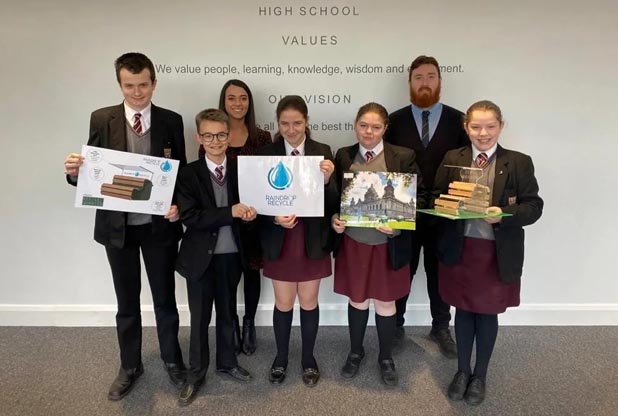
3. Health-shoe project by Royal Docks Academy students
Meanwhile in Newham, London, Year 10 students at Royal Docks Academy turned their attention to health innovation. The group developed a “vibrogen boot”, inspired by power plates found in gyms to support health and wellbeing in an ageing society. The footwear was designed to apply vibration to stimulate circulation during walking.
Through this innovative science project, these students further illustrated what science in schools can achieve and how it can be applied to meet the demands of the future, such as an ageing society.
4. Ava Garside’s air quality sensor
Next, we have thirteen-year-old Ava Garside from Leeds, who developed an air quality sensor in response to the ‘Clean Growth’ challenge. The challenge focuses on accelerating low carbon innovations to help industries reduce greenhouse gas emissions. It supports the development of cleaner technologies, fuels and infrastructure such as hydrogen, bioenergy and clean electricity to drive progress towards net zero.
Ava’s wearable device collects real-time data on local air quality, helping users identify the cleanest and healthiest routes to school or work. This increases awareness of the local environment and levels of pollution. What began as a school science project has now led Ava to collaborate with scientists at the University of Manchester, refining her prototype into a compact, stylish pin-badge.
5. AI Wellbeing Device by Students at Northwood College for Girls
Keeping with the theme of girls in STEM, two year 9 students from Northwood College for Girls in London worked on an impressive project. The pair demonstrated exceptional design capability with their entry for the ‘Samsung Solve for Tomorrow Competition’.
Their innovative science project, Soothe Space, focused on promoting healthier lifestyles through technology. The device combines multiple wellbeing features, including heart-rate monitoring, an AI chatbot for motivation or advice and mindfulness tools such as guided breathing and daily activity prompts. Together, these functions encourage users to develop positive habits and improve overall wellbeing. Despite over 1,000 entries, the girls were awarded runner up for their age group.
Indeed, their achievement highlights the value of inspiring science spaces. Klick Technology provided the specialist science lab furniture for the school’s new science block, creating a light and modern space which helps fuel students’ creativity.
Watch the video to hear from students and staff at Northwood College as they share their feedback on Klick’s recent science block installation.
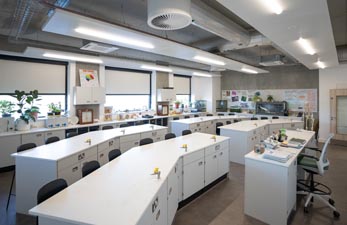
Testimonial
“The finished labs at Northwood College showcase the thought that went into the interiors from Klick and everyone else involved. We were really pleased with the quality and design of the laboratory furniture and it is always good to get positive feedback from those using the space.”
Anna Gillies – Associate, IID Architects – Re Northwood College, London
6. Hydro-electric plumbing at Mary Webb School and Science College
The final project was developed by a group of Year 11 students at the Mary Webb School and Science College in Shrewsbury. Responding to the ‘Clean Growth’ challenge, the team designed a hydroelectric plumbing system that aims to reduce energy waste, lower carbon emissions and decrease society’s reliance on mass electricity generation.
Through fitting a small device that acts as a miniature hydroelectric generator, their invention harnesses the flow of water through household pipes. The device represents how science in schools can support the transformation we need for the future.
The six projects above highlight how practical science education can inspire innovation and problem-solving. To support this, it’s important that school laboratories are designed to encourage hands-on learning in a safe and efficient environment.
At Klick Technology, we understand the impact that well-designed science classrooms can have on student engagement and teacher delivery. A functional layout, durable furniture and organised storage all contribute to creating an effective learning space. This includes:
- Durable, high-quality furniture – manufactured in the UK using robust materials designed to withstand the demands of daily use
- Organised storage solutions – from mobile and fixed tray units to clearly labelled chemical cupboards, ensuring a tidy and compliant workspace
- Integrated teaching walls – improving student engagement, lesson flow and classroom organisation
- Designs supporting collaboration and STEM engagement – fostering curiosity and problem-solving among students
- Future-ready layouts – allowing for easy updates as technology and curriculum needs evolve
Conclusion: Inspiring the Future through Science in Schools
These six projects have been a reminder that teen inventions can lead to real-world innovation. Each project demonstrates how creativity, collaboration and curiosity can shape a more sustainable future for us all.
Here at Klick we believe that supporting science in schools goes beyond lessons and experiments; it is about creating science laboratories where young pupils have the freedom to explore and reach their potential.
Partnering for Success
Klick have been involved in the design and fit out of laboratories for over 40 years. Whether you’re designing a new science lab or upgrading an existing one, remember that every detail counts. If you would like to take advantage of Klick’s experience and expertise in designing Science Laboratory Furniture for Schools or Commercial Laboratory Environments our consultants would be happy to help.
Please call 0161 998 9726 or contact us by email to arrange a consultation.
Sources:
British Science Association – 10 cool science projects created by kids addressing real-world problems | British Science Association
Northwood College for Girls – Samsung Solve for Tomorrow Competition – Northwood College for Girls
Science Focus. 10 cool projects created by kids addressing real-world problems – 10 cool projects created by kids addressing real-world problems – BBC Science Focus Magazine
UK Government Clean Growth Grand Challenge – Clean Growth Grand Challenge: Industrial Clusters Mission – infographic
UNESCO World Science Day for Peace and Development – World Science Day for Peace and Development | UNESCO
